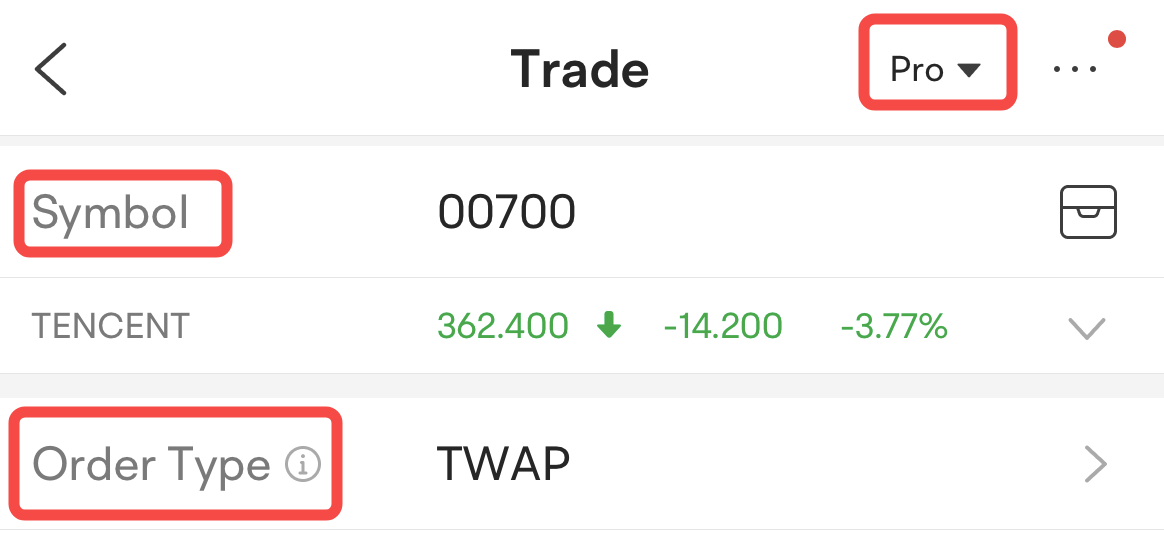What is Algorithmic Trading for HK Stocks
1. What is Algorithmic Trading ("Algo Trading")?
Algo trading uses a computer program that follows a defined set of instructions (an algorithm) to place a trade. The algorithm could define variables such as timing, price, volume, or any mathematical model. The computer program will automatically monitor stock prices and place buy and sell orders when defined conditions are met.
2. Algo Order Types
The algo orders you can place with Moomoo SG include TWAP and VWAP orders.
2.1 TWAP Order
A TWAP order splits one large order into smaller orders based on the TWAP (Time-Weighted Average Price) Algorithm that aims to achieve an execution price close to the intraday market TWAP over a defined time period.
2.2 VWAP Order
A VWAP order splits one large order into smaller orders based on the VWAP (Volume-Weighted Average Price) Algorithm that aims to achieve an execution price close to the intraday market VWAP over a defined time period.
3. How to place an algo order?
You can see TWAP and VWAP orders in the drop-down box in the moomoo app when placing an order for an HK stock symbol.

*The above pictures are for illustration purposes only and do not constitute investment advice.
If you choose TWAP:
● Enter the price, then the quantity, and set the start time and end time of execution;
● Tap "Buy" or "Sell", then you can successfully submit the order.
If you choose VWAP:
● Enter the price, then the quantity, set the start time and end time of execution, and enter the maximum participation ratio;
● Tap "Buy" or "Sell", then you can successfully submit the order.
4. Notes
We may adjust the scope of products available for algo orders from time to time, and the availability of algo orders for a particular product shall be determined by what is described on the page when placing an order.
5. Algo Trading Fees
For HK stocks, 0.05% of the transaction amount is charged on top of the standard fees.
6. Risk Disclosure on Algorithmic Trading
There are special characteristics and risks associated with algorithmic trading. You should read the risk disclosure statement in relation to algorithmic trading before entering into any transactions. You should understand these risks and determine whether algorithmic trading is appropriate in light of your objectives and experience.
(1) Technical Errors: Algorithmic trading can be affected when your systems, the Company's systems, or the Exchange's system is experiencing technical difficulties. Risks include possible delays or failures in (i) the availability of your connection to the Company's services and of the Company's services to the relevant Exchange; (ii) the operation of databases and internal transfers of data; (iii) the provision of data feeds (accuracy of data and stability of data connections); (iv) possible hardware failures; (v) usage loads, bandwidth limitations, and other bottlenecks inherent in computerized and networked architectures; (vi) issues, disputes, or failures of third party vendors and other dependencies; and (vii) other general risks inherent in computer-based operations. Any of these could lead to delays or failures in order execution, incorrect order execution, and other problems.
(2) Software and Design Flaws: All software is subject to inadvertent programming errors and bugs embedded in the code comprising that software. Algo order types may contain logical errors in the code to implement them. Errors may exist in the data used for testing the algorithm or the applicable model of the market. Despite testing and monitoring, inadvertent errors and bugs may still cause algo orders to fail or run incorrectly.
(3) Market Impact and Events: Market conditions will impact the execution of algo orders. Possible adverse market conditions include a lack of liquidity, price swings, late market openings, early market closings, market chaos, mid-day trading pauses, and other disruptive events. The execution of an algorithm can itself have an impact on the market, including causing a lack of liquidity or abrupt, unwarranted price swings.
(4) Losses: Losses can happen more quickly with electronic and algorithmic trading compared to other forms of trading. Any or all of the above risk factors could cause more significant trading losses when using algorithmic trading compared to other forms of trading.